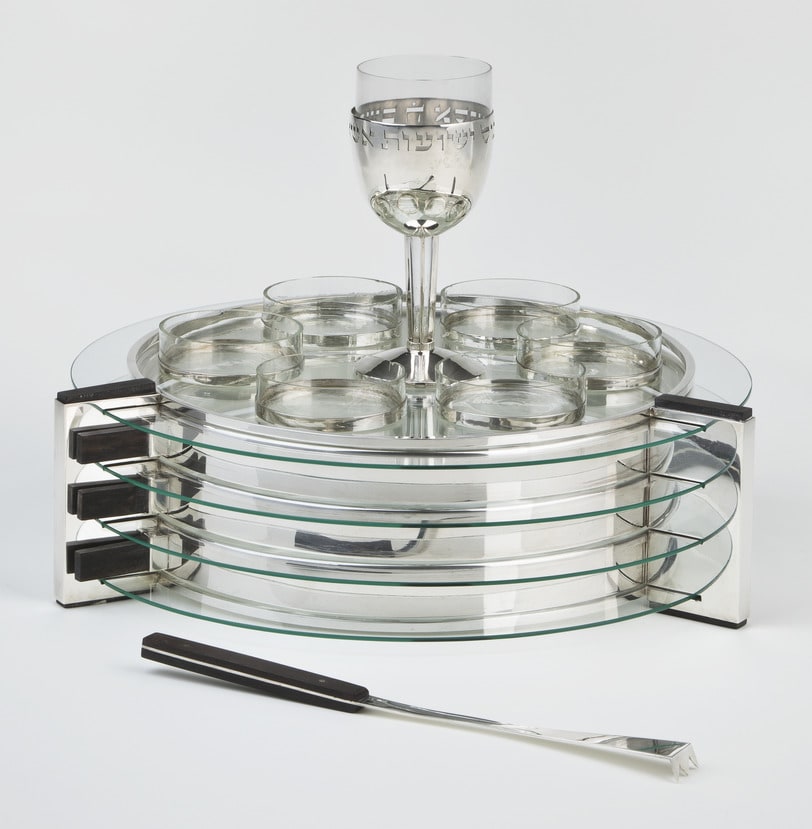
- Object Name:
- Passover Set
- Artist/Maker:
- Ludwig Yehuda Wolpert
- Bio:
- b. 1900, Hildesheim, Germany; d. 1981, New York
- Place Made:
- New York, United States
- Date:
- designed 1930, Frankfurt; fabricated 1978
- Medium:
- Silver, ebony, and glass
- Dimensions:
- Seder Plate: 4 1/16 × 13 5/16 × 11 7/16 in. (10.3 × 33.8 × 29.1 cm) Cup: 6 3/16 × 2 7/8 in. (15.7 × 7.3 cm)
- Credit Line:
- Gift of Sylvia Zenia Rosen Wiener
- Accession Number:
- 2012-26a-m
Not On View
The aesthetic principles advocated by the Bauhaus in the 1920s-that form and function were mutually dependent, that fine design should be aimed at mass production, that ornament should be banned-pervaded international artistic thought for much of the twentieth century. At first considered radical by many, the numerous Bauhaus designs that are still produced today testify to their viable aesthetic and practical values.
Ludwig Wolpert is the first metalworker to apply these progressive principles to the fabrication of Jewish ceremonial art. His Passover service, a copy after a lost original designed in 1930, may be his masterpiece. Its conception and execution aptly express the ideas generated by the Bauhaus School, first during its years at Weimar and then in Dessau. Wolpert gleaned many of these concepts from his Bauhaus-trained teacher Leo Horowitz and also became aware of burgeoning Bauhaus design through publications and colleagues.
The form of this set is based on earlier, lavishly decorated examples. Following Bauhaus precepts of minimal embellishment and maximum visual effect, Wolpert pared the multilevel server down to its essential functions in a highly calibrated play with contrasting materials. Three circular tiers above a conforming silver base are joined at equidistant points by vertical ebony and silver mounts. Notched to support the glass shelves, the mounts double as handles. Horizontal silver bands that separate each tier slide open to reveal a space, within which the symbolic matzah can be placed. The cutout Hebrew inscription "I will lift the cup of salvation, and call upon the name of the Lord" appears on the glass-lined silver goblet. This receptacle holds the wine symbolically set aside for the prophet Elijah. Practical, industrially replicable, cylinder-shaped glass dishes, meant to contain the ritual foods, have been set into precious silver mounts.
The design of the tiered platter, aside from the cutout inscription, is founded entirely on the appeal of its high-contrast materials. Wolpert's inspiration for his combination of wood, glass, and metal may have come from Josef Albers's berry dishes and teacups of 1923-25. Yet Wolpert applies these ideas to an infinitely more complex object with a rationality and a thorough understanding of the relationship of weighted objects in three-dimensional space. This latter conception conforms with the thinking of Moholy-Nagy, an important teacher at the Bauhaus, who strove to derive uncompromising new forms that could also be mass-produced. Although the fabrication of this seder plate was too difficult for large-scale production, it was carefully replicated several times.
A substantial part of Wolpert's later work, including Hanukkah lamps, memorial lights, and kiddush goblets, was indeed designed for mass production. Ultimately, the artist successfully adapted Bauhaus philosophy to the production of well-designed ritual domestic wares still available today.
Ludwig Wolpert is the first metalworker to apply these progressive principles to the fabrication of Jewish ceremonial art. His Passover service, a copy after a lost original designed in 1930, may be his masterpiece. Its conception and execution aptly express the ideas generated by the Bauhaus School, first during its years at Weimar and then in Dessau. Wolpert gleaned many of these concepts from his Bauhaus-trained teacher Leo Horowitz and also became aware of burgeoning Bauhaus design through publications and colleagues.
The form of this set is based on earlier, lavishly decorated examples. Following Bauhaus precepts of minimal embellishment and maximum visual effect, Wolpert pared the multilevel server down to its essential functions in a highly calibrated play with contrasting materials. Three circular tiers above a conforming silver base are joined at equidistant points by vertical ebony and silver mounts. Notched to support the glass shelves, the mounts double as handles. Horizontal silver bands that separate each tier slide open to reveal a space, within which the symbolic matzah can be placed. The cutout Hebrew inscription "I will lift the cup of salvation, and call upon the name of the Lord" appears on the glass-lined silver goblet. This receptacle holds the wine symbolically set aside for the prophet Elijah. Practical, industrially replicable, cylinder-shaped glass dishes, meant to contain the ritual foods, have been set into precious silver mounts.
The design of the tiered platter, aside from the cutout inscription, is founded entirely on the appeal of its high-contrast materials. Wolpert's inspiration for his combination of wood, glass, and metal may have come from Josef Albers's berry dishes and teacups of 1923-25. Yet Wolpert applies these ideas to an infinitely more complex object with a rationality and a thorough understanding of the relationship of weighted objects in three-dimensional space. This latter conception conforms with the thinking of Moholy-Nagy, an important teacher at the Bauhaus, who strove to derive uncompromising new forms that could also be mass-produced. Although the fabrication of this seder plate was too difficult for large-scale production, it was carefully replicated several times.
A substantial part of Wolpert's later work, including Hanukkah lamps, memorial lights, and kiddush goblets, was indeed designed for mass production. Ultimately, the artist successfully adapted Bauhaus philosophy to the production of well-designed ritual domestic wares still available today.
Information may change as a result of ongoing research.